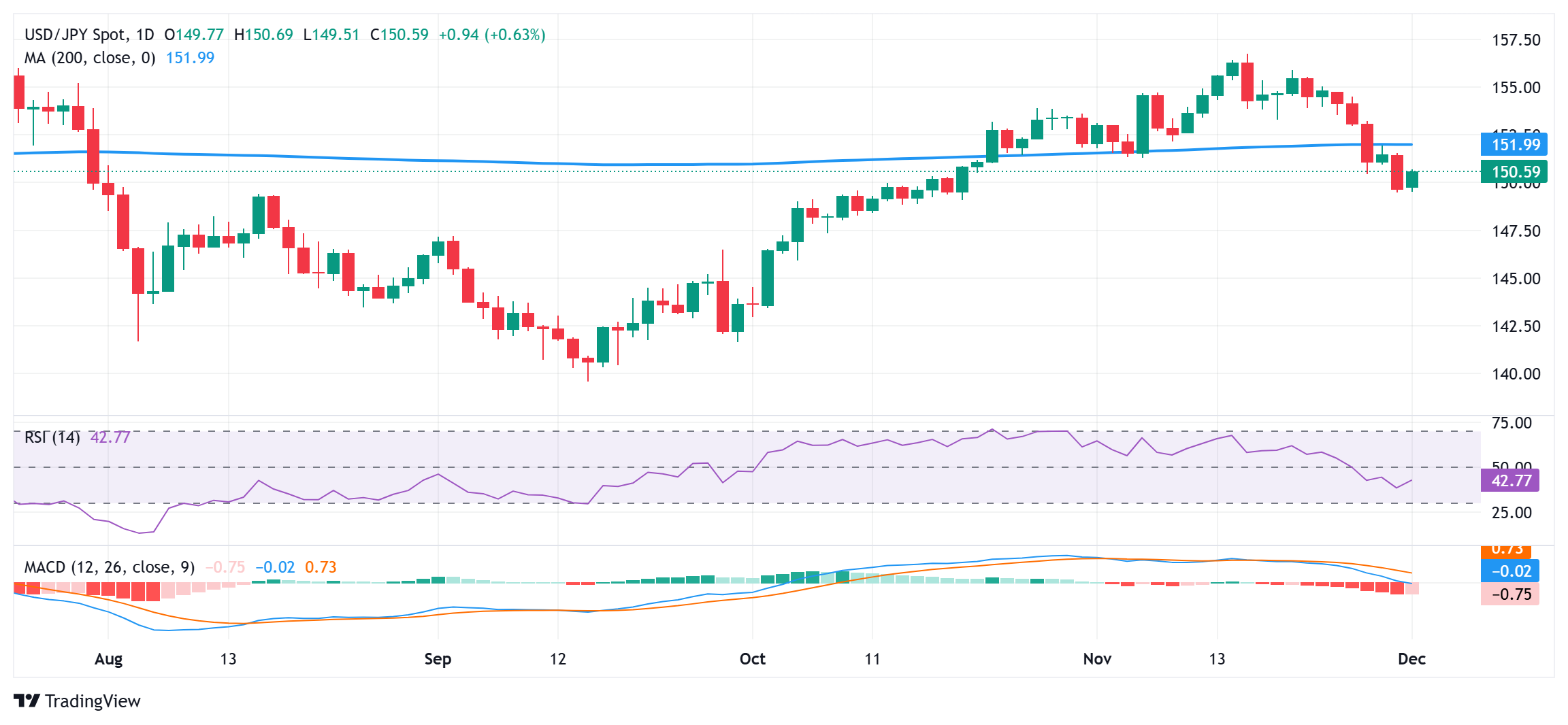- The Japanese Yen weakens against the USD and is affected by a combination of factors.
- Rebounding US bond yields and a positive risk tone push safe-haven JPY flows away.
- A strong rebound in USD demand contributes to USD/JPY’s move back above the mid-150.00s.
The Japanese Yen (JPY) falls against its US counterpart at the start of a critical week and reverses part of Friday’s strong bullish move to the highest level since October 21. US Treasury yields regain positive traction in reaction to US President-elect Donald Trump’s threat to impose 100% tariffs on BRICS nations. This, in turn, helps revive demand for the US Dollar (USD) and turns out to be a key factor shifting flows away from the underperforming JPY.
Apart from this, the underlying bullish tone in equity markets further undermines the demand for the safe-haven JPY. That said, lingering geopolitical tensions and increasing bets on another interest rate cut by the Bank of Japan (BoJ) in December should limit the JPY’s deeper losses. Traders could also refrain from opening aggressive directional bets and opt to wait for this week’s important US macroeconomic releases, starting with the ISM Manufacturing PMI later this Monday.
Japanese Yen Draws New Sellers as Rising US Bond Yields Rekindle USD Demand; bets on a BoJ rate hike could limit losses
- US President-elect Donald Trump threatened a 100% tariff on the so-called ‘BRICS’ nations – Brazil, Russia, India, China and South Africa – if they replace the US dollar with another currency for international transactions.
- This adds to Trump’s promise to impose large tariffs against the United States’ three largest trading partners – Mexico, Canada and China – and heightens market concerns about a second wave of a global trade war.
- Investors now appear convinced that Trump’s tariff plans and his expansionary policy could boost consumer prices, setting the stage for the Federal Reserve to stop cutting interest rates or possibly raise them again.
- Prospects of a less dovish Fed trigger a fresh rise in US bond yields, helping the USD recover from a near three-week low and seen shifting flows away from the low-yielding Japanese Yen.
- Stronger consumer inflation figures on Friday in Tokyo, Japan’s capital, signaled that core inflation is gaining momentum and supported the case for another rate hike by the Bank of Japan in December.
- BoJ Governor Kazuo Ueda said on Saturday that the next interest rate hikes are close in the sense that economic data is on the way, although he would like to see what kind of momentum the Fiscal Shunto 2025 creates.
- Japan’s Finance Ministry reported on Monday that capital spending rose 8.1% year-on-year in the third quarter, indicating that strong domestic demand was underpinning the fragile economic recovery.
- Russian and Syrian warplanes have carried out a series of airstrikes against Syrian rebels led by the jihadist group Hayat Tahrir al-Sham, who seized most of Aleppo in a surprise offensive on Saturday and also entered the city of Hama.
- Ukrainian President Volodymyr Zelenskyy has declared that he is willing to cede occupied Ukrainian territory to Russia, albeit with some conditions, to reach a ceasefire agreement and achieve peace.
- China’s official manufacturing Purchasing Managers’ Index (PMI) rose to 50.3 in November from 50.2, while the NBS non-manufacturing PMI fell to 50.0 during the reported month from 50.2 in October.
- China’s Caixin Manufacturing Purchasing Managers’ Index (PMI) jumped to 51.5 in November after recording 50.3 in October, amid hopes that the government will introduce more stimulus to boost domestic demand.
- Investors now await this week’s major US macroeconomic releases, including the US monthly employment details (NFP) report, for clues on the Fed’s future rate cut path and a significant boost.
USD/JPY could struggle to capitalize on the positive move and remain capped near the 200-day SMA pivotal resistance
From a technical perspective, any further move higher will likely face strong resistance near the 151.00 round level amid negative oscillators on the daily chart. Sustained strength beyond, however, could trigger a short-covering rally and lift the USD/JPY pair towards the intermediate hurdle of 151.65 en route towards the 152.00 level. The latter represents the very important 200-day SMA and should act as a key pivot point. Some continuation buying will suggest that the recent corrective pullback from a multi-month high has come to an end and shift the short-term bias in favor of bullish traders.
On the other hand, the psychological level of 150.00 now seems to protect the immediate decline before Friday’s low, around the 149.45 region. Some follow-through selling has the potential to drag the USD/JPY pair further towards the round figure of 149.00 en route towards the next relevant support of 147.60-147.55 and the 148.00 level (50% retracement level of the September rally- November).
The Japanese Yen FAQs
The Japanese Yen (JPY) is one of the most traded currencies in the world. Its value is determined broadly by the performance of the Japanese economy, but more specifically by the policy of the Bank of Japan, the differential between the yields of Japanese and US bonds or the risk sentiment among traders, among other factors.
One of the mandates of the Bank of Japan is currency control, so its movements are key for the Yen. The BoJ has intervened directly in currency markets on occasion, usually to lower the value of the Yen, although it often refrains from doing so due to the political concerns of its major trading partners. The BoJ’s current ultra-loose monetary policy, based on massive stimulus to the economy, has caused the depreciation of the Yen against its main currency pairs. This process has been exacerbated more recently by a growing policy divergence between the Bank of Japan and other major central banks, which have opted to sharply raise interest rates to combat decades-old levels of inflation.
The Bank of Japan’s ultra-loose monetary policy stance has led to increased policy divergence with other central banks, particularly the US Federal Reserve. This favors the widening of the spread between US and Japanese 10-year bonds, which favors the Dollar against the Yen.
The Japanese Yen is often considered a safe haven investment. This means that in times of market stress, investors are more likely to put their money in the Japanese currency due to its supposed reliability and stability. In turbulent times, the Yen is likely to appreciate against other currencies that are considered riskier to invest in.
Source: Fx Street
I am Joshua Winder, a senior-level journalist and editor at World Stock Market. I specialize in covering news related to the stock market and economic trends. With more than 8 years of experience in this field, I have become an expert in financial reporting.








